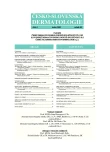Cutaneous Alternariosis – a Diagnostic and Therapeutic Problem
Authors:
M. Skořepová; J. Štork; J. Stará
Authors‘ workplace:
Dermatovenerologická klinika 1. LF UK a VFN Praha
přednosta prof. MUDr. J. Štork, CSc.
Published in:
Čes-slov Derm, 80, 2005, No. 1, p. 15-18
Category:
Case Reports
Overview
A 53-year-old woman developed two livid-pinkish smooth nodules on her right extremity two months after renal transplantation. Clinical picture was suggestive for the diagnosis of malignant lymphoma but histopathology examination revealed a cutaneous mycosis and tissue cultivation yielded an Alternaria sp. The nodule on the forearm was totally excised while the nodule on the dorsum of the hand had to be left in place considering its localization, size and the immune suppression due to prednisone, azathioprine and tacrolimus. Systemic antifungal monotherapy with itraconazole and terbinafine, successively, failed. On the contrary, new cutaneous lesions appeared. Combined therapy with itraconazole 400 mg a day and terbinafine 250 mg a day continued for 4 months led to complete resolution.
Key words:
cutaneous alternariosis – differential diagnosis – therapy
Labels
Dermatology & STDs Paediatric dermatology & STDsArticle was published in
Czech-Slovak Dermatology

2005 Issue 1
Most read in this issue
- Multicentric Reticulohistiocytosis
- Mycophenolate Mofetil in the Treatment of Some Skin Diseases
- Cutaneous Alternariosis – a Diagnostic and Therapeutic Problem
- Photo(chemo)therapy in Dermatological Treatment
